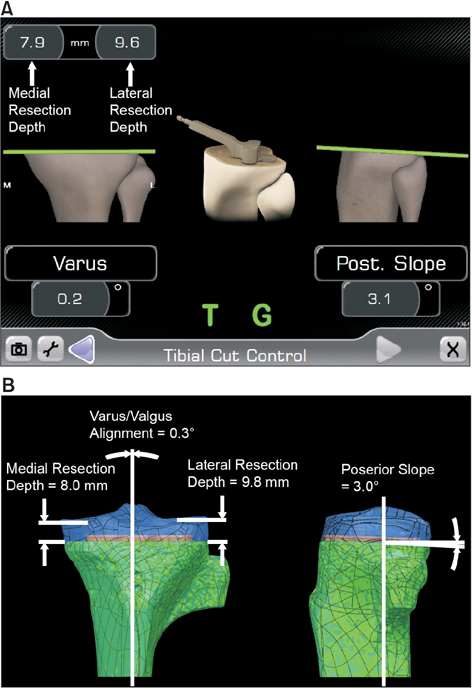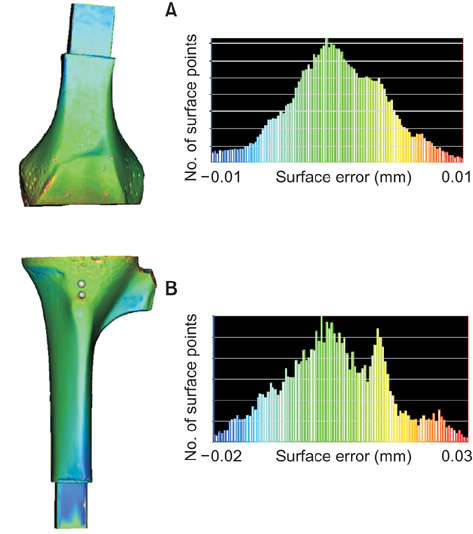Clin Orthop Surg.
2015 Jun;7(2):225-233. 10.4055/cios.2015.7.2.225.
Evaluation of the Accuracy and Precision of a Next Generation Computer-Assisted Surgical System
- Affiliations
-
- 1Engineering and Development, Knee, Exactech Inc., Gainesville, FL, USA. Laurent.Angibaud@exac.com
- 2North Carolina Specialty Hospital, Durham, NC, USA.
- KMID: 2164549
- DOI: http://doi.org/10.4055/cios.2015.7.2.225
Abstract
- BACKGROUND
Computer-assisted orthopaedic surgery (CAOS) improves accuracy and reduces outliers in total knee arthroplasty (TKA). However, during the evaluation of CAOS systems, the error generated by the guidance system (hardware and software) has been generally overlooked. Limited information is available on the accuracy and precision of specific CAOS systems with regard to intraoperative final resection measurements. The purpose of this study was to assess the accuracy and precision of a next generation CAOS system and investigate the impact of extra-articular deformity on the system-level errors generated during intraoperative resection measurement.
METHODS
TKA surgeries were performed on twenty-eight artificial knee inserts with various types of extra-articular deformity (12 neutral, 12 varus, and 4 valgus). Surgical resection parameters (resection depths and alignment angles) were compared between postoperative three-dimensional (3D) scan-based measurements and intraoperative CAOS measurements. Using the 3D scan-based measurements as control, the accuracy (mean error) and precision (associated standard deviation) of the CAOS system were assessed. The impact of extra-articular deformity on the CAOS system measurement errors was also investigated.
RESULTS
The pooled mean unsigned errors generated by the CAOS system were equal or less than 0.61 mm and 0.64degrees for resection depths and alignment angles, respectively. No clinically meaningful biases were found in the measurements of resection depths (< 0.5 mm) and alignment angles (< 0.5degrees). Extra-articular deformity did not show significant effect on the measurement errors generated by the CAOS system investigated.
CONCLUSIONS
This study presented a set of methodology and workflow to assess the system-level accuracy and precision of CAOS systems. The data demonstrated that the CAOS system investigated can offer accurate and precise intraoperative measurements of TKA resection parameters, regardless of the presence of extra-articular deformity in the knee.
MeSH Terms
Figure
Reference
-
1. Fehring TK, Odum S, Griffin WL, Mason JB, Nadaud M. Early failures in total knee arthroplasty. Clin Orthop Relat Res. 2001; (392):315–318.2. Schroer WC, Berend KR, Lombardi AV, et al. Why are total knees failing today? Etiology of total knee revision in 2010 and 2011. J Arthroplasty. 2013; 28:8 Suppl. 116–119.3. Sharkey PF, Hozack WJ, Rothman RH, Shastri S, Jacoby SM. Insall Award paper: why are total knee arthroplasties failing today? Clin Orthop Relat Res. 2002; (404):7–13.4. Jeffery RS, Morris RW, Denham RA. Coronal alignment after total knee replacement. J Bone Joint Surg Br. 1991; 73(5):709–714.5. Ritter MA, Faris PM, Keating EM, Meding JB. Postoperative alignment of total knee replacement: its effect on survival. Clin Orthop Relat Res. 1994; (299):153–156.6. Wasielewski RC, Galante JO, Leighty RM, Natarajan RN, Rosenberg AG. Wear patterns on retrieved polyethylene tibial inserts and their relationship to technical considerations during total knee arthroplasty. Clin Orthop Relat Res. 1994; (299):31–43.7. Berend ME, Ritter MA, Meding JB, et al. Tibial component failure mechanisms in total knee arthroplasty. Clin Orthop Relat Res. 2004; (428):26–34.8. Fang DM, Ritter MA, Davis KE. Coronal alignment in total knee arthroplasty: just how important is it? J Arthroplasty. 2009; 24:6 Suppl. 39–43.9. Kim YH, Park JW, Kim JS, Park SD. The relationship between the survival of total knee arthroplasty and postoperative coronal, sagittal and rotational alignment of knee prosthesis. Int Orthop. 2014; 38(2):379–385.10. Ensini A, Catani F, Leardini A, Romagnoli M, Giannini S. Alignments and clinical results in conventional and navigated total knee arthroplasty. Clin Orthop Relat Res. 2007; 457:156–162.11. Parratte S, Pagnano MW, Trousdale RT, Berry DJ. Effect of postoperative mechanical axis alignment on the fifteen-year survival of modern, cemented total knee replacements. J Bone Joint Surg Am. 2010; 92(12):2143–2149.12. Baker PN, van der Meulen JH, Lewsey J, Gregg PJ. National Joint Registry for England and Wales. The role of pain and function in determining patient satisfaction after total knee replacement: data from the National Joint Registry for England and Wales. J Bone Joint Surg Br. 2007; 89(7):893–900.13. Bourne RB, Chesworth BM, Davis AM, Mahomed NN, Charron KD. Patient satisfaction after total knee arthroplasty: who is satisfied and who is not? Clin Orthop Relat Res. 2010; 468(1):57–63.14. Rothwell AG, Hooper GJ, Hobbs A, Frampton CM. An analysis of the Oxford hip and knee scores and their relationship to early joint revision in the New Zealand Joint Registry. J Bone Joint Surg Br. 2010; 92(3):413–418.15. Matsuda S, Kawahara S, Okazaki K, Tashiro Y, Iwamoto Y. Postoperative alignment and ROM affect patient satisfaction after TKA. Clin Orthop Relat Res. 2013; 471(1):127–133.16. Jenny JY, Clemens U, Kohler S, Kiefer H, Konermann W, Miehlke RK. Consistency of implantation of a total knee arthroplasty with a non-image-based navigation system: a case-control study of 235 cases compared with 235 conventionally implanted prostheses. J Arthroplasty. 2005; 20(7):832–839.17. Rosenberger RE, Hoser C, Quirbach S, Attal R, Hennerbichler A, Fink C. Improved accuracy of component alignment with the implementation of image-free navigation in total knee arthroplasty. Knee Surg Sports Traumatol Arthrosc. 2008; 16(3):249–257.18. Sparmann M, Wolke B, Czupalla H, Banzer D, Zink A. Positioning of total knee arthroplasty with and without navigation support: a prospective, randomised study. J Bone Joint Surg Br. 2003; 85(6):830–835.19. Zhang GQ, Chen JY, Chai W, Liu M, Wang Y. Comparison between computer-assisted-navigation and conventional total knee arthroplasties in patients undergoing simultaneous bilateral procedures: a randomized clinical trial. J Bone Joint Surg Am. 2011; 93(13):1190–1196.20. Carli A, Aoude A, Reuven A, Matache B, Antoniou J, Zukor DJ. Inconsistencies between navigation data and radiographs in total knee arthroplasty are system-dependent and affect coronal alignment. Can J Surg. 2014; 57(5):305–313.21. Marin F, Mannel H, Claes L, Durselen L. Accurate determination of a joint rotation center based on the minimal amplitude point method. Comput Aided Surg. 2003; 8(1):30–34.22. Wiles AD, Thompson DG, Frantz DD. Accuracy assessment and interpretation for optical tracking systems. Proc SPIE. 2004; 5367:421–432.23. Hernandez-Vaquero D, Suarez-Vazquez A, Sandoval-Garcia MA, Noriega-Fernandez A. Computer assistance increases precision of component placement in total knee arthroplasty with articular deformity. Clin Orthop Relat Res. 2010; 468(5):1237–1241.24. Lustig S, Fleury C, Servien E, Demey G, Neyret P, Donell ST. The effect of pelvic movement on the accuracy of hip centre location acquired using an imageless navigation system. Int Orthop. 2011; 35(11):1605–1610.
- Full Text Links
- Actions
-
Cited
- CITED
-
- Close
- Share
- Similar articles
-
- Corrigendum to "Evaluation of the Accuracy and Precision of a Next Generation Computer-Assisted Surgical System"
- Computer-Assisted Navigation in High Tibial Osteotomy
- Computer-Assisted Spine Surgery (CASS)
- Computer-Assisted Total Hip Arthroplasty
- Application of Virtual Surgical Planning with Computer Assisted Design and Manufacturing Technology to Cranio-Maxillofacial Surgery




